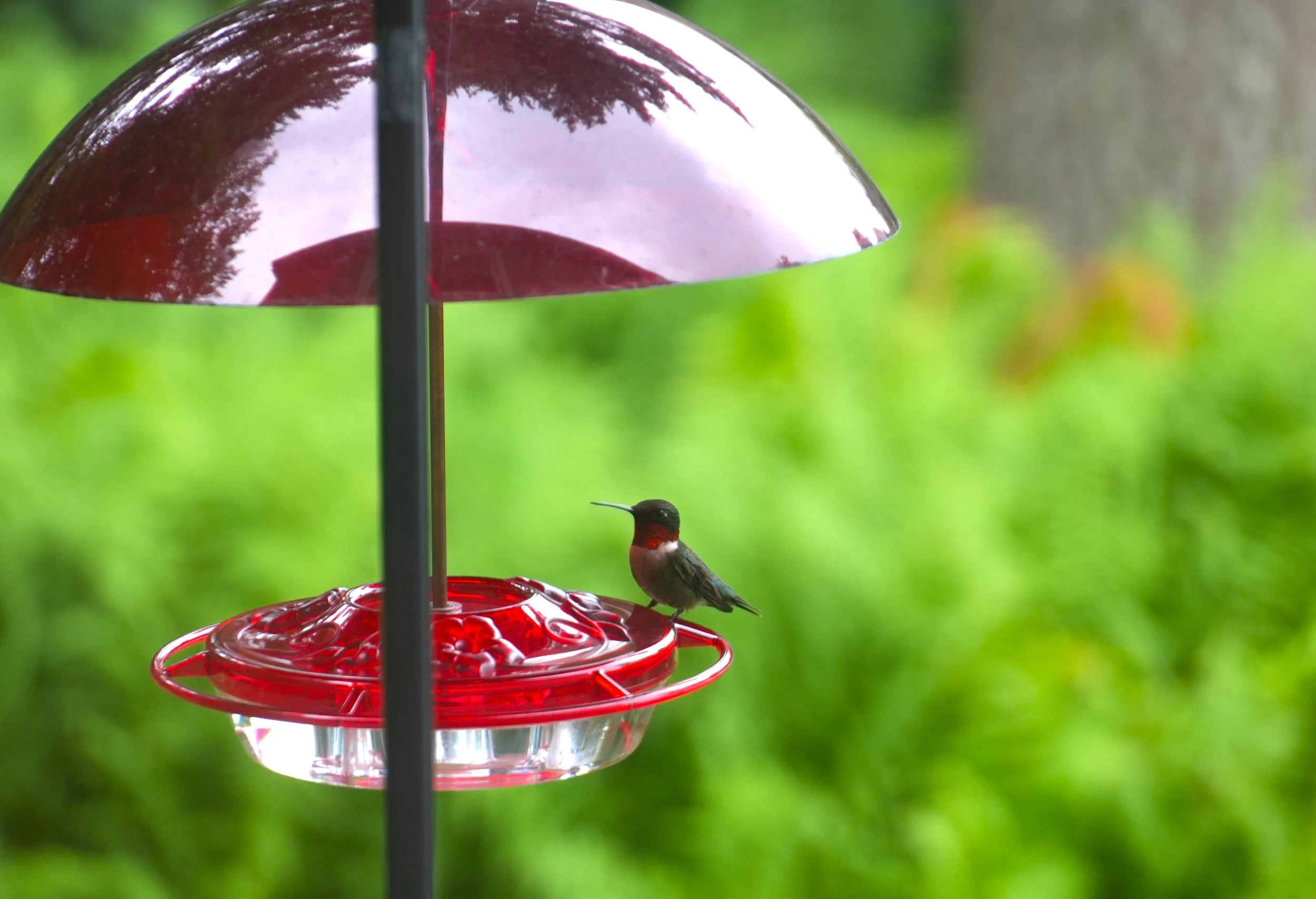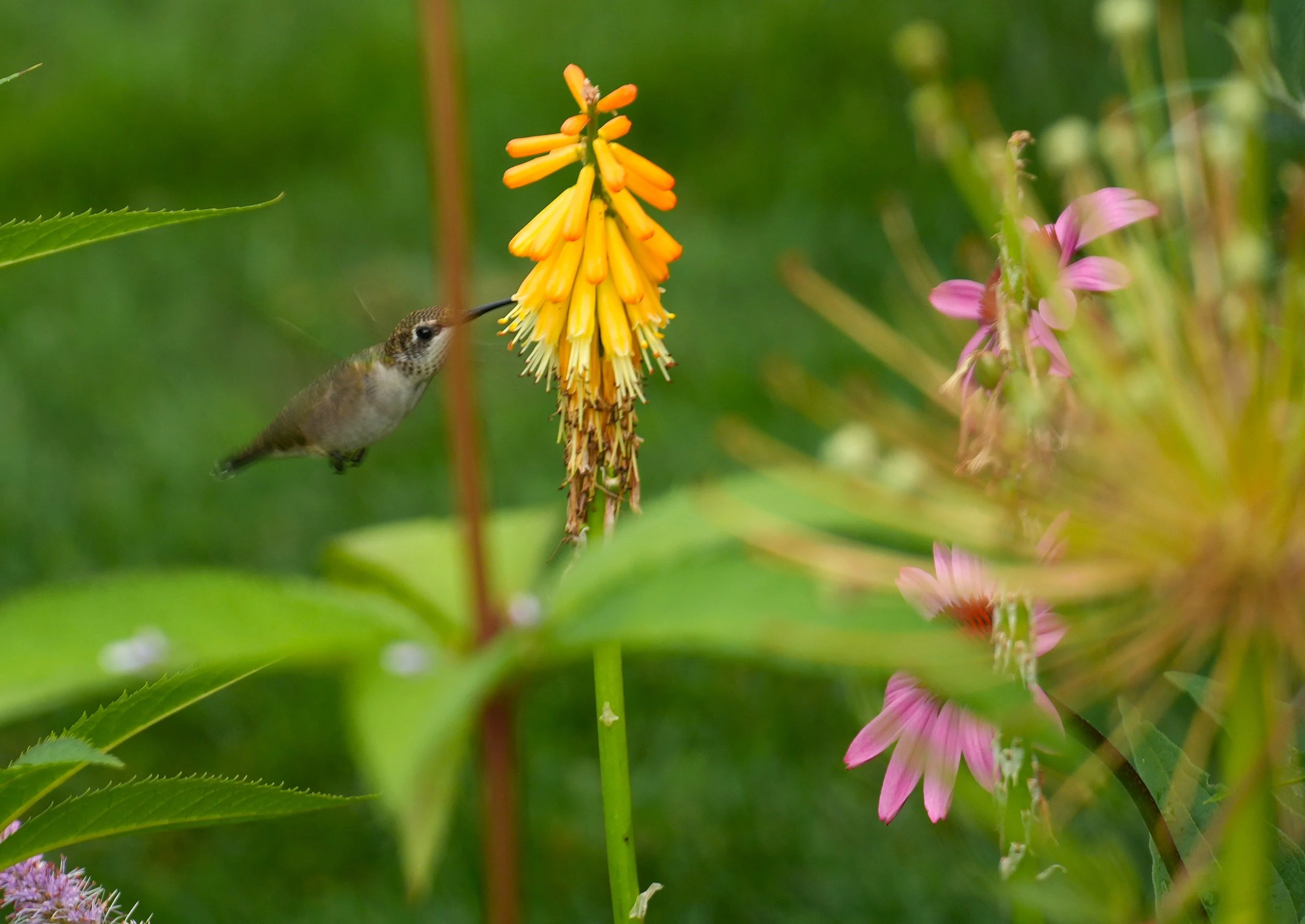taming the July garden & finding beauty amid the chaos
Oops ~ it happened…again
This is the time of year when you blink and suddenly your perfectly balanced and well-behaved June garden, all sparkly and fresh, has turned into a Hydra monster, growing uncontrollably and looking a fright. It seems that some plants have exploded with growth from rain and are now huge and floppy, while other plants are stunted or have wilted and gone crunchy from dry periods. My baptisia ‘Purple Smoke’ shown here has achieved enormous proportions and needs to be tamed a bit. The good news is that baptisia is quite accommodating and the stem cuttings are fantastic additions to cut flower arrangements.
In a perfect world, we would always adhere to ‘right plant, right place’ when choosing our plant locations. But in reality, we gardeners are prone to pairing plants that ‘look pretty together’ only to discover later that they have different water requirements. Getting the irrigation ‘right’ so everyone can be happy is often a monumental challenge.
drip, drip, drip
The Big Little Garden has drip irrigation tubing throughout, nestled just under an inch or two of shredded leaf and pine needle ‘mulch’ that we make here from our own trees. The drip is a life saver, and is super customizable so we can offer water when and where it’s needed and avoid it where it isn’t. But it’s still not ‘perfect’. And as we have learned at the Community Hospice House gardens, drip is not adequate to establish new trees with large root balls.
For new trees and shrubs, I recommend this 24” Reotemp moisture meter. The 24” probe allows you to more accurately gauge the true hydration deep into the plant’s root ball, not just in the top few inches from the surface. NOTE: this model requires calibration prior to use.
taming ginormous plants!
Today, I’ll demonstrate how to quickly thin out and scale down some of my um…er…’happier’ plants. It’s no secret that I prefer to plant densely as this eliminates the need for much, if any, mulch, and provides biodiversity and floral density to better support our pollinators. However, I do like to thin plants a bit to give them breathing room and to improve air circulation to minimize disease stressors. The easy approach is to simply remove stems at ground level all around the circumference of the plant. NOTE: this garden, like almost all my other gardens was not raked or aggressively cleaned last fall nor this spring. Plants emerge through the decomposing debris, creating dense tapestries of foliage and bloom. The perfect habitat for our beneficial insects!
observing & learning
We can learn a lot by observing ‘volunteer’ plants in the garden, like the daucus carota aka Queen Anne’s Lace in my mailbox garden. I didn’t plant it. It just showed up. Why? because a seed flew in and the conditions in this bed were ‘just right’ for it to establish and flourish. I love this unexpected nature of my garden and love giving volunteer plants a chance to see how they perform. The tiny bees and other insects love daucus carota and I appreciate how the flat umbellifers contrast with the spiky red hot poker plants. As other perennials in this garden bed fade, the daucus will continue to perform for weeks on end. Daucus is a non-native species that has naturalized throughout North America. Of course any non-native invasive plants like bittersweet are eliminated as soon as I see them lurking!
‘go away obnoxious people!’
A favorite native plant of mine is verbena hastata. ‘Blue Vervain’ satisfies my desire for plants that are both funky and productive for wildlife (check, check)! Found throughout North America, verbena hastata towers over neighboring plants in my east facing bed. According to the folks at Native Plant Trust ‘Go Botany’, the Iroquois valued it as witchcraft medicine ‘to make obnoxious persons go away’. For my purposes, I value it as a superb pollinator and host plant. Native Plant Trust tells us: "Wildlife Benefits include: Larval host plant for verbena moth (Crambodes taliformis) and common buckeye butterfly (Junonia coenia). Important food source for specialist bee, Calliopsis nebraskensis. Seeds are eaten by cardinals, swamp sparrows, field sparrows, song sparrows, and dark eyed juncos.
time to fertilize!
Yes, we just discussed taming and cutting back. But we also need to keep plants healthy and give them proper nourishment. This is especially the case for container plants. My favorite approach is to apply Neptune’s Harvest seaweed and fish emulsion with a hose-end sprayer. Spray directly onto foliage in very early morning or early evening, being certain to avoid applying during times of bright sun. Your garden will smell like the beach for a day or two, but your plants will respond beautifully! Suitable for container and in-ground annuals, perennials and shrubs.
finding joy amid the chaos
Let’s face it, there’s only so much taming that one can do before losing one’s mind. So, my approach is to take a deep breath, nip around the edges, then relax and enjoy the show. The birds and insects don’t care if your garden isn’t perfect. And most human visitors to your garden won’t see the ‘warts’ that you do. So try to let go a bit and focus on the beautiful habitat that you have built for our wondrous creatures! I received a fancy new camera for my birthday and have been having fun trying to capture the birds in the garden. I’m a novice and never seem to have the right settings, but am learning!
community hospice house update
CHH volunteers have been working tirelessly to wrangle the dozens of gardens that exploded this spring while we were distracted with the plant sale. In addition to taming the madness, we have been focused on planting the bioswale and I’ll be sharing more about that soon. Meanwhile, the meadow that we planted from seed in November, 2023 is stunning with non-stop bloom since early May. Currently, the stars are the rudbeckia hirta, aka ‘Black Eyed Susans’ and the monarda fistulosa.
The most impressive thing to me is that we scattered seed in late fall 2023 on a wing and a prayer that the sub-standard soil that contractors dumped in this area post-construction would be able to sustain life. Boy does it ever! This area is not irrigated, has not been fertilized, and received no leaf compost. It is totally self-sustaining. We have added plugs of monarda fistulosa and penstemon hirsutus that will add more extended color next year. Last month, volunteers planted about 30 native little bluestem and big bluestem grasses that will plume and lighten up the palette in late summer. The insect and bird activity in this area is unreal. It’s my happy place!
massive allium sale coming!
We will be offering thousands of allium bulbs of 19 different varieties this fall as a fundraiser for the Community Hospice House gardens. Bulbs will arrive early October and will be available for you all to purchase shortly thereafter.
Varieties include: Ambassador, Atropropureum, Azureum, Christophii, Cowanii, Gladiator, Globemaster, Mount Everest, Moly, Nectaroscordum, Nigrum, Pinball Wizard, Ping Pong, Purple Rain, Purple Sensation, Red Mohican, Sphaerocephalon, and Triquetrum. Whew!
So, stay tuned for more details and plan accordingly for your garden!
Until next time, stay calm and garden on.
~ Barb











